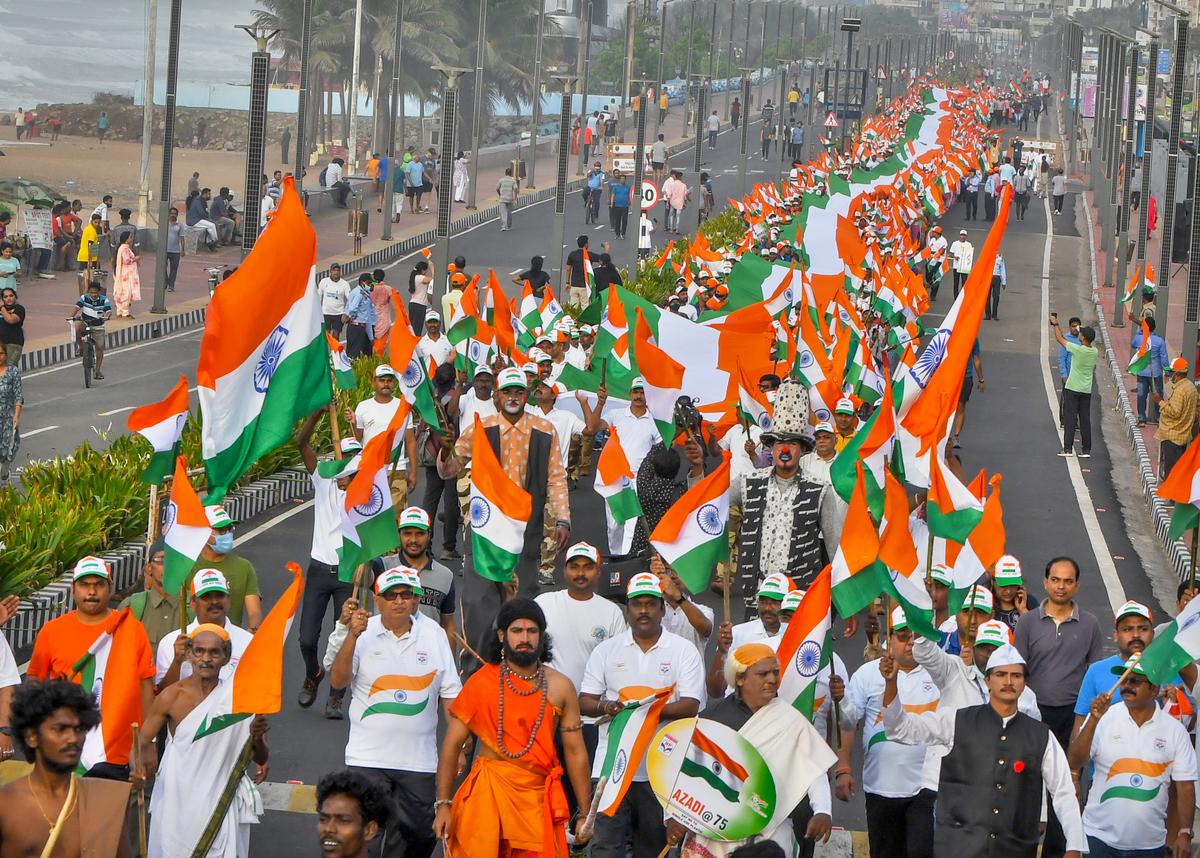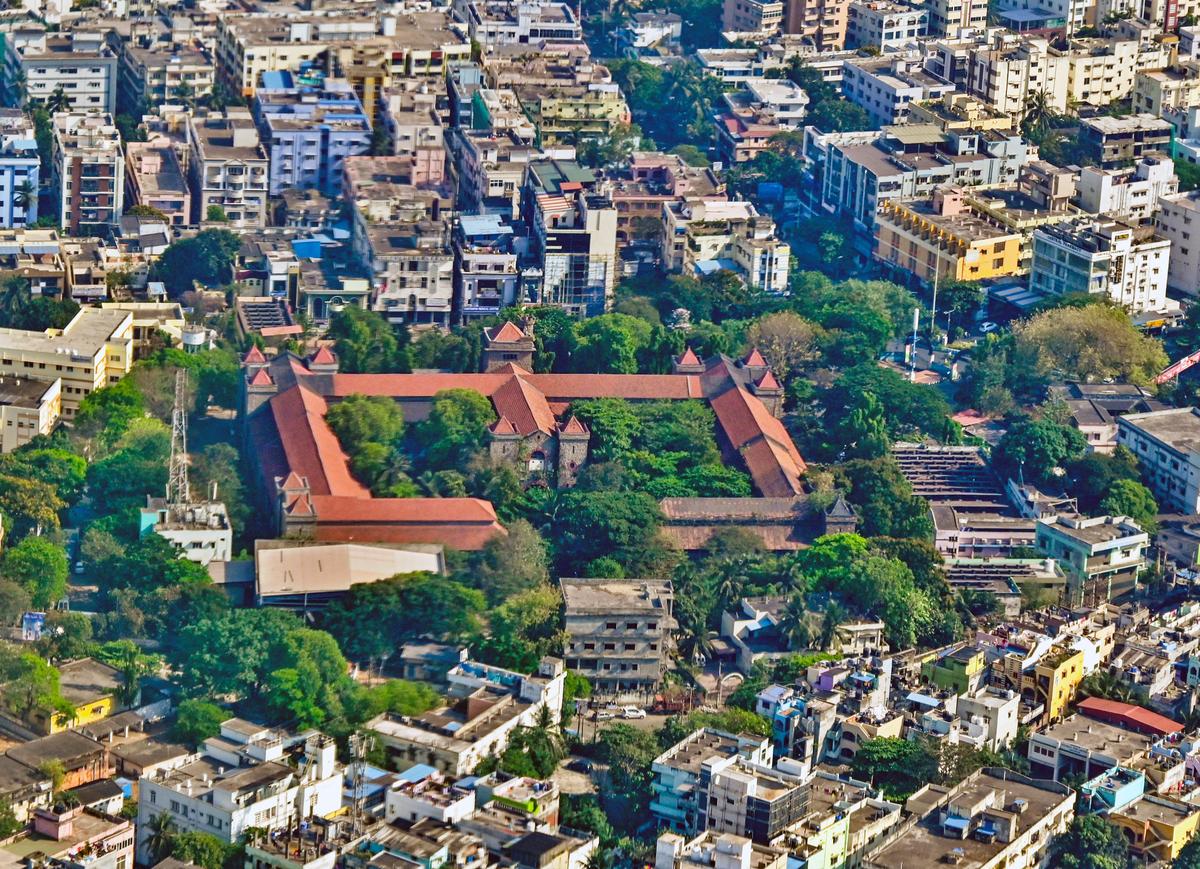While much of India’s freedom struggle is told through events in Delhi, Mumbai and Kolkata, Visakhapatnam had its own powerful, if quieter, moments of resistance. From salt-laden hands held high at the beach to fiery speeches in the Town Hall, these landmarks narrate the city’s fight for swaraj.
In the 1940s, Visakhapatnam was a relatively small coastal town with fewer organised public events when compared to major urban centres of the Independence Movement. Yet the spaces and stories that have survived from that period reveal a city fully engaged in the struggle, albeit in its own manner.
The dawn of freedom

Thousands of people participating in the flag rally at the Beach Road in Visakhapatnam.
| Photo Credit:
KR Deepak
For heritage narrator Jayshree Hatangadi, memories of August 15, 1947, have always been coloured by her grandmother’s vivid storytelling. CV Ratnamani, born in 1918, described the day as one of unrestrained celebration in Visakhapatnam. Drums echoed near Kurupam Market for days. Residents wore khadi. Women wore strings of white and orange flowers in their hair. At the entrances of homes, chukkala muggus in the shape of Gandhiji’s charkha appeared in saffron, white and green.
“Proud and excited, my parents were taken to see the India map outlined in glowing lights on the facade of Poorna Theatre (at that time in One Town), where they stood still and saluted,” says Jayshree. Their father, CV Ramana Murthy, presented them with small silver flag brooches, identical to those sold at the family store, the Eastern Art Museum.
Town Hall: A stage for awakening

The Visakhapatnam Town Hall.
| Photo Credit:
Special Arrangement
Long before freedom, the Town Hall had been central to the city’s political awakening. Its foundation stone was laid on April 3, 1901 and it was inaugurated on March 8, 1904, by RH Campbell, then District Collector of Vizagapatam (a district in the Madras Presidency of British India). The building’s stone-walled Gothic structure soon became synonymous with public discourse, protest and civic assembly.
In 1906, the hall hosted early Vande Mataram meetings, gatherings that drew the attention and suspicion of the colonial authorities. On April 6, 1919, the city observed Satyagraha Day against the Rowlatt Act, with residents filling the hall to hear excerpts from Gandhi’s writings in an open challenge to the Press Act, says Jayshree.
According to heritage enthusiast and INTACH (Indian National Trust for Art and Cultural Heritage) member Edward Paul, the Town Hall also became a cultural hub. “It is an iconic building, not only for its architecture, but for the calibre of events it hosted,” he says. The stage saw performances by MS Subbulakshmi, Dwaram Venkataswamy Naidu, and public lectures by Sarojini Naidu, Sarvepalli Radhakrishnan, CV Raman and Rabindranath Tagore.
Through the 1920s and 1930s, the hall was a forum for debate on non-cooperation, the boycott of foreign cloth and women’s participation in the Freedom Movement. Jayshree shares, “Students from Andhra University marched to the building in khadi caps, organising mock parliaments and affirming Gandhi’s call for self-reliance. Even under strict surveillance, meetings continued, often disguised as cultural evenings to avoid British interference.”
The shoreline protest: Town Hall Beach
The stretch of shore near the Town Hall, now part of the Visakha Container Terminal, became the site of the city’s Salt Satyagraha. When Gandhi visited in April 1929, the number of women participants exceeded that of men. Among them was 10-year-old K Sarojini, Jayshree’s mother’s cousin, who donated her gold bangle to support the cause.
During the same campaign, Digumarthi Janakibai assumed leadership when male organisers were arrested. She held a fistful of salt so firmly that the tahsildar pricked her hand to force it out. She later gave birth to her first child in jail while serving her sentence.
Streets of defiance

Hindu Reading Room or Reading Room, an important landmark in Visakhapatnam.
| Photo Credit:
KR Deepak
The reading room, once housed in a dilapidated building by Maharajah Gode Narayana Gajapathi Rao, was rebuilt in 1917 by his daughter, the Rani Sahiba of Wadhwan, in his memory. Inaugurated in 1917 by the then Governor of Madras, John Baron Pentland, the motto of the room was to promote reading during colonial times.
Among the city’s oldest reading spaces, it once housed a well-stocked library that drew scholars and citizens alike. Its quiet walls have witnessed many historic moments, including visits by Sri Tenneti Viswanadham and Tagore. In 1932, Kapuganti Chidambaram was compelled to walk from the Hindu Reading Room to the One Town Police Station while being beaten repeatedly. Witnesses recalled that he continued to chant ‘Vande Mataram’ until he collapsed. Incidents such as these did not become national headlines, yet they marked the determination of the city’s residents to take risks for the cause of freedom.
A rare moment in the Collectorate
The National Flag flying atop the district collectors office in Visakhapatnam. The collector office was inaugurated on August 15, 1913, and on Aug 15 1947 the Union Jack was permanently brought down the flag post and the national flag was hoisted.
| Photo Credit:
KR Deepak
One of the most unusual events of Visakhapatnam’s independence history took place at the Collectorate. On August 15, 1947, AH Southern, the British Collector of Vizag, personally lowered the Union Jack and raised the Indian tricolour.

An aerial view of over a century-old Collectorate building seen amidst modern concrete jungle. The construction of the ediffice began in 1865 and was completed in 1914, and since then it has been operational as Collector’s office, in Visakhapatnam.
| Photo Credit:
KR Deepak
The act was given further significance by the fact that the same building had been inaugurated on August 15, 1913, exactly 34 years earlier. According to Edward Paul, the Indian flag was also hoisted that day at the Police Barracks by the Collector.
Published – August 14, 2025 05:13 pm IST